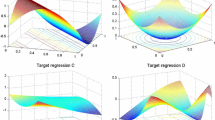Abstract
Optimal bandwidth choice for matching estimators and their finite sample properties are examined. An approximation to their MSE is derived, as a basis for a plug-in bandwidth selector. In small samples, this approximation is not very accurate, though. Alternatively, conventional cross-validation bandwidth selection is considered and performs rather well in simulation studies: Compared to standard pair-matching, kernel and ridge matching achieve reductions in MSE of about 25 to 40%. Local linear matching and weighting perform poorly. Furthermore, the scope for developing better bandwidth selectors seems to be limited for ridge matching, but non-negligible for kernel and local linear matching.
Similar content being viewed by others
References
Abadie A. and Imbens G. 2001. Simple and Bias-Corrected Matching Estimators for Average Treatment Effects, mimeo, Harvard University.
Angrist J. 1998. Estimating labour market impact of voluntary military service using social security data. Econometrica 66: 249– 288.
Dehejia R. and Wahba S. 1999. Causal effects in non-experimental studies: Reevaluating the evaluation of training programmes. Journal of American Statistical Association 94: 1053–1062.
Fan J. 1993. Local linear regression smoothers and their minimax efficiency. Annals of Statistics 21: 196–216.
Fan J., Gasser T., Gijbels I., Brockmann M. and Engel J. 1997. Local polynomial regression: Optimal kernels and asymptotic minimax efficiency. Annals of the Institute of Mathematical Statistics 49: 79–99.
Fan J. and Gijbels I. 1996. Local Polynomial Modeling and its Applications. Chapman and Hall, London.
Frölich M. 2002. Propensity score matching without conditional independence assumption-with an application to the gender wage gap in the UK. mimeo, University of St. Gallen.
Gerfin M. and Lechner M. 2002. Microeconometric evaluation of the active labour market policy in switzerland. Economic Journal 112: 854–893.
Gu X. and Rosenbaum P. 1993. Comparison of multivariate matching methods: Structures, distance, and algorithms. Journal of Computational and Graphical Statistics 2: 405–420.
Hahn J. 1998. On the role of the propensity score in efficient semiparametric estimation of average treatment effects. Econometrica 66: 315–331.
Heckman J., Ichimura H., Smith J. and Todd P. 1998. Characterizing selection bias using experimental data. Econometrica 66: 1017–1098.
Heckman J., Ichimura H. and Todd P. 1997. Matching as an econometric evaluation estimator: Evidence from evaluating a job training programme. Review of Economic Studies 64: 605–654.
Heckman J., Ichimura H. and Todd P. 1998. Matching as an econometric evaluation estimator. Review of Economic Studies 65: 261– 294.
Heckman J. and Robb R. 1985. Alternative methods for evaluating the impact of interventions. In: Heckman J. and Singer B. (Eds.) Longitudinal Analysis of Labour Market Data, Cambridge University Press, Cambridge.
Hirano K., Imbens G. and Ridder G. 2003. Efficient estimation of average treatment effects using the estimated propensity score. Econometrica 71: 1161–1189.
Horvitz D. and D. Thompson 1952. A generalization of sampling without replacement from a finite population. Journal of American Statistical Association 47: 663–685.
Imbens G. 2000. The role of the propensity score in estimating dose-response functions. Biometrika 87: 706–710.
Lechner M. 1999. Earnings and employment effects of continuous off-the-job training in east germany after unification. Journal of Business and Economic Statistics 17: 74–90.
Little R. and Rubin D. 1987. Statistical Analysis with Missing Data. Wiley, New York.
Loader C. 1999. Bandwidth selection: Classical or plug-in?. Annals of Statistics 27: 415–438.
Pagan A. and A. Ullah 1999. Nonparametric Econometrics. Cambridge University Press. Cambridge.
Rosenbaum P. and Rubin D. 1983. The central role of the propensity score in observational studies for causal effects. Biometrika 70: 41–55.
Ruppert D. and Wand M. 1994. Multivariate locally weighted least squares regression. Annals of Statistics 22: 1346–1370.
Seifert B. and Gasser T. 1996. Finite-sample variance of local polynomials: Analysis and solutions. Journal of American Statistical Association 91: 267–275.
Seifert B. and Gasser T. 2000. Data adaptive ridging in local polynomial regression. Journal of Computational and Graphical Statistics 9: 338–360.
Author information
Authors and Affiliations
Corresponding author
Rights and permissions
About this article
Cite this article
Frölich, M. Matching estimators and optimal bandwidth choice. Stat Comput 15, 197–215 (2005). https://doi.org/10.1007/s11222-005-1309-6
Received:
Accepted:
Issue Date:
DOI: https://doi.org/10.1007/s11222-005-1309-6




